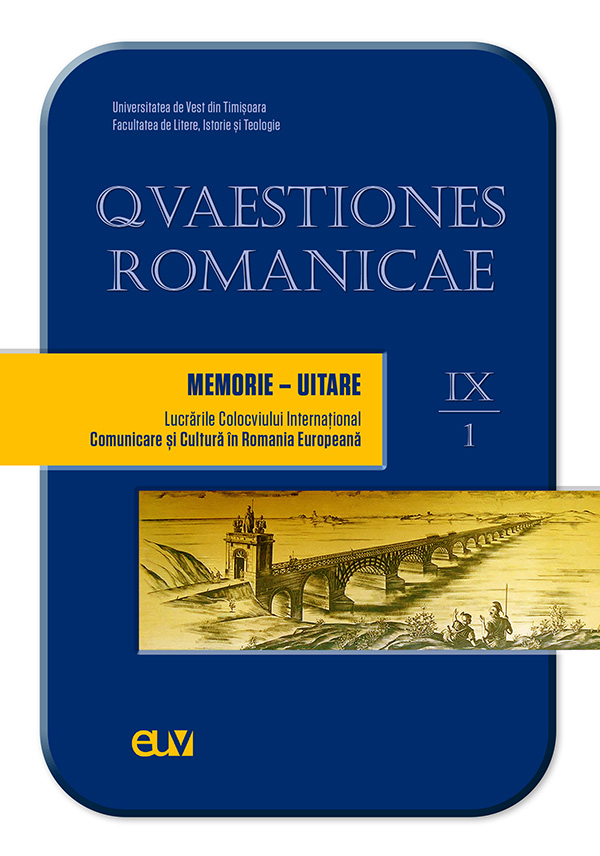Lingvistica istorică romanică și efectele înșelătoare ale unor prejudecăți care favorizează limbile standard. Două exemple din istoria limbii române
Abstract: (Romance historical linguistics and the misleading effects of standard language bias) Two examples from the history of Romanian. This study examines two examples from the morphological history of the Romance languages whose development has been distorted, not to say misrepresented, because of a kind of methodological prejudice which attributes excessive importance to standard languages, while ignoring dialectal and comparative evidence. Such an approach risks serious misunderstanding of the history not only of the dialects, but of the standard languages themselves. Two phenomena from the history of Romanian will be particularly considered: (i) in the third person plural present indicative of verbs such as a veni we find not the expected iotacized form **viu from ueniunt (cf. old Italian vegnono, and also first person singular viu in old Romanian and vegno in old Italian from uenio), but the non-iotacized form vin(u); (ii) the Latin verb FIERI appears in Romanian in the subjunctive of the verb a fi, but not in the present indicative. The first phenomenon has recently been attributed (see Elson 2017; but also Maiden 2020; 2021) to historical contact between Romanian and middle Bulgarian (where a similar pattern of allomorphy existed). Elson assumes that the corresponding standard Italian forms are the normal development for ‘eastern’ Romance languages, Romanian being a deviation from that ‘norm’ explicable by Bulgarian influence. Actually, the evidence of other Italo-Romance dialects (and other Romance languages) clearly shows the exact reverse: the ‘deviant’ language is standard Italian, while Romanian is an absolutely ‘normal’ Romance language in that respect. There are therefore no grounds to invoke Bulgarian influence. As for a fi, various linguists (Streller 1904, Philippide [2011], Capidan 1932, Rosetti 1986, and others) have assumed—lending excessive importance to the well-kown structures of modern standard Romaian—that the forms fiu, fii, fim, fiți were originally limited to the subjunctive by their very nature. These scholars overlook the dialectal and comparative data (not just from Daco-Romanian, Aromanian, Megleno-Romanian, and Istro-Romanian, but also from Italo-Romance and Sardinian), which show that fiu, fii, fim, fiți (and possibly even fie) ar must have existed in proto-Daco-Romance as forms of the present indicative, only later being analogically extended into the subjunctive. In conclusion I will again stress the importance of a truly comparative perspective in historical reconstruction which does not place misleading emphasis on the familiar standard languages.
Keywords: reconstruction, morphology, standard languages, Romanian, Italian.
Rezumat: Studiul analizează două exemple din istoria morfologică a limbilor romanice a căror dezvoltare a fost denaturată, ca să nu spunem interpretată greșit din cauza unei prejudecăți metodologice care acordă o importanță excesivă limbilor standard, ignorând dovezile dialectale și comparative. O astfel de abordare poate duce la o înțelegere eronată nu numai a istoriei dialectelor, ci și a istoriei limbilor standard însele. Două fenomene din istoria limbii române vor fi luate în mod special în considerare: (i) la persoana a treia plural la timpul prezent, modul indicativ a unor verbe precum a veni, nu găsim forma iotacizată **viu pe care am aștepta-o de la UENIUNT (v. italiana veche vegnono, precum și persoana întâi singular viu în româna veche și vegno în italiana veche de la UENIO), ci forma non-iotacizată vin(u); (ii) verbul latin FIERI apare în limba română în forma de conjunctiv a verbului a fi, dar nu la indicativ prezent. Primul fenomen a fost atribuit recent (v. Elson 2017; dar și Maiden 2020; 2021) contactului istoric dintre română și bulgara veche (unde exista un tipar asemănător de alomorfie). Elson presupune că formele corespunzătoare din italiana standard reprezintă dezvoltarea normală pentru limbile romane „estice”, limba română fiind o excepție de la „norma” explicabilă prin influența bulgară. De fapt, dovezi din alte dialecte italo-romanice (și alte limbi romanice) arată clar exact contrariul: limba „deviantă” este italiana standard, în vreme ce limba română este o limbă romanică absolut „normală” în această privință. Prin urmare, nu există motive pentru a invoca influența bulgară. În ceea ce privește verbul a fi, diverși lingviști (Streller 1904, Philippide [2011], Capidan 1932, Rosetti 1986 și alții) au presupus – acordând importanță structurilor binecunoscute ale românei moderne standard – că formele fiu, fii, fim, fiți erau inițial limitate la modul conjunctiv prin însăși natura lor. Acești cercetători însă nu au luat în considerare informațiile dialectale și comparative (nu numai din daco-română, aromână, megleno-română și istro-română, ci și din italoromanică și sardă), care arată că fiu, fii, fim,fiți (posibil chiar și fie) trebuie să fi existat în proto-daco-romană ca forme ale indicativului prezent, fiind abia ulterior extinse în mod analogic la modul conjunctiv. În concluzie, voi sublinia din nou importanța perspectivei cu adevărat comparative în reconstituirea istorică, ce nu evidențiază în mod eronat familiarele limbi standard.
Cuvinte-cheie: reconstrucția, morfologia, limbile standard, limba română, limba italiană.
